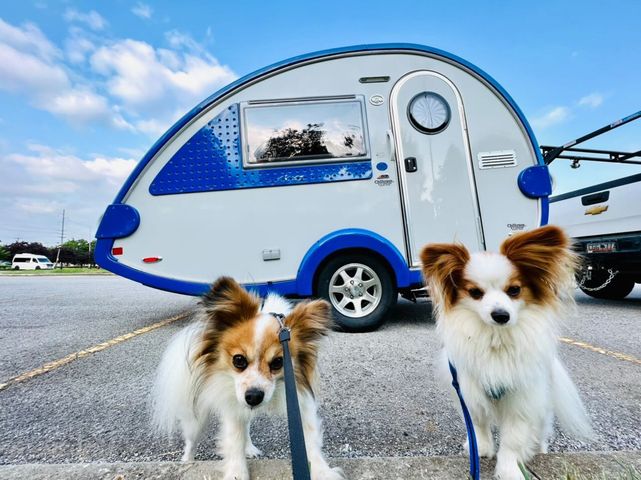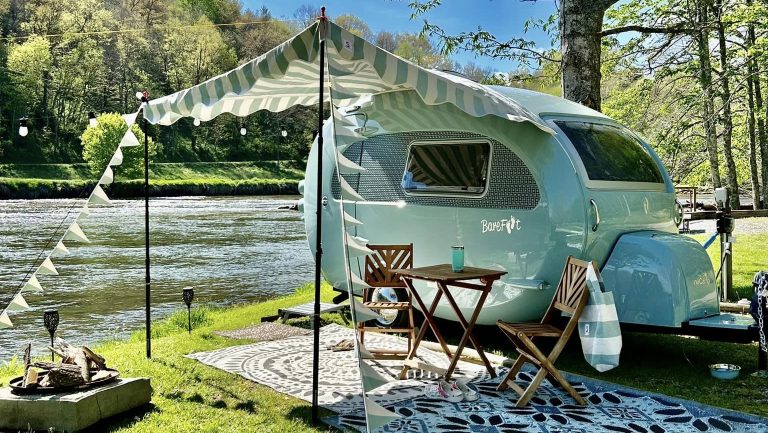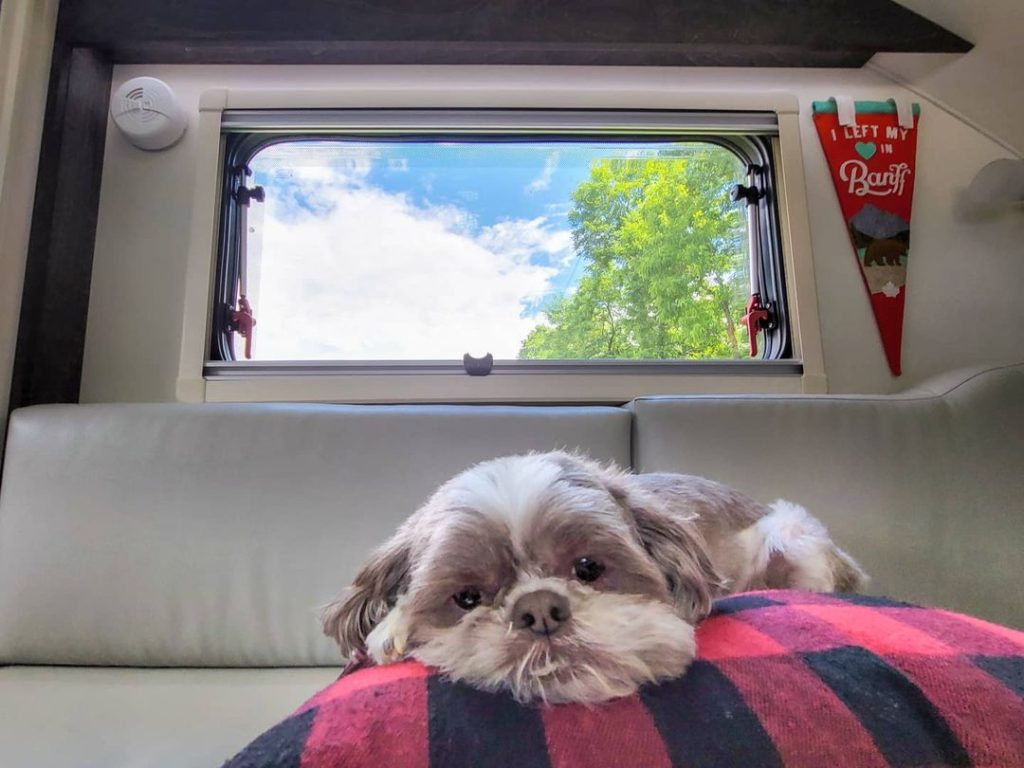Camping is better with a furry friend!
We know how it is! Your pet is part of your family, and you just can’t bear the thought of leaving Fluffy or Fido (or your bird, fish, or reptile) at home while you head out on the road in your camper. Or maybe you’re a full-timer who wants some non-human companionship while exploring the highways and byways.
We did some research on traveling with pets and pulled together tips from experts and other campers so the journey is safe for your furred, finned, feathered, or scaled traveling buddy. For more information, check out our post, Camping with Fluffy and Fido.
Acclimate your pet
Experts and pet-owning campers agree that preparation is critical when it comes to keeping your pet safe and happy on the road. You can’t just dump your pet into your camper and take off. While some dogs may take to it right away, being in a small space can take time to get used to for other dogs and pets. Your pet has to feel comfortable in/get acclimated to the new surroundings. That may take at least a week or two while the camper is parked in your driveway and your pet (depending on the species) has the run of the interior. (RV Life Pro has a great step-by-step post on this.) Then, do some practice runs close to home with your pet to get it accustomed to the feel and sounds of a moving vehicle.

Have appropriate restraints or cages
Have appropriate restraints or travel crates for your pet, and plan on keeping your pet in your tow vehicle, not your camper, while traveling. The Center for Pet Safety has great advice on traveling with pets as well as harness and carrier information so your pet is restrained and safe. Then consider protecting the cushions in your camper with old sheets or pet blankets. The coverings can be shaken out each day to reduce pet hair and make for a quicker clean-up in case of any “accidents.”
Know the rules and regulations
Research rules and regulations at campgrounds and national, state, and local parks, or other planned stopping areas that may apply to your non-human travel buddy. Is there a “no dogs” rule or a ban on certain sizes, breeds, or species? According to Go Rving, “Some campgrounds, and/or destinations you travel to have Breed Specific Legislation or BSL laws or insurance guidelines that prohibit dogs they consider as bully breeds.”
Check vaccination and license status
Make sure your pet is current with all vaccinations and licensing, then ask your veterinarian about any additional shots or health-related tips based on your travel destination. Prepare a fully stocked pet first aid kit using the ASPCA and the American Veterinary Medical Association lists as a guide, and download the Red Cross first aid app. Finally, have a list of animal hospitals and vets along your travel route.
Prepare for “just in case” situations
Follow this advice from Go Pet Friendly: Prepare an envelope with emergency instructions with your pet’s vaccination information, contact information for the veterinarian, and an emergency contact person if you are unable to care for your pet. Make sure the envelope is marked “In Case of Emergency” and tape it in a highly visible spot inside your tow vehicle. Then keep a second set with you when you’re not in your car or truck. Add in some photos, a description of your pet, and any other relevant information such as allergies or health conditions. Also, consider having your pet microchipped or tagged with a QR pet id tag just in case you get separated.
Consider your pet’s needs
Evaluate your travel and camping plans, taking into account your pet’s needs. You may need to stop every few hours to let your pet do its business or stretch its legs. Once at your stopping place, don’t just leave your pet behind in the camper while you explore the area on foot or in your vehicle. Not only could the interior reach temperatures that could be deadly, but in some places, leaving your pet alone could be considered animal abuse, subjecting you to a fine. In the winter, the opposite situation could occur, where temps drop far below what certain pets can safely handle. If you like the idea of parking your camper and then being gone for hours, consider boarding your pet instead of bringing it along.

Species-Specific Tips
The following provides some species-specific tips but always check with your veterinarian for more information.
Cats and Dogs
Leash training is critical, especially if you’re planning on exploring the great outdoors with your cat or dog. Planning on camping off-the-grid? Keep in mind that boondocking is, by its nature, being out in the wild, and for many of its natural inhabitants, your house pet may look more like a potential meal. You’ll also want to make sure your pet doesn’t disrupt the natural wildlife.

Environmental dangers such as foxtails and goat head stickers can pose dangers, too, notes Katt Annie in her book, The Safe, Solo RV Nomad: Enjoy the Freedom of Nomadic Living Without Any Fear. At the campground, Katt Annie sets up portable dog fencing and places a tarp on the ground to give her dog a safe and secure place to enjoy the great outdoors. It’s up to you to know what is prevalent in the areas that you’ll be visiting and take precautions to protect your pet.
As for kitty, try this modification from Mamie Konarski, a member of the nuCamp Owners Group, designed to give her eight-year-old cat Zippy a way to enjoy the view without escaping the camper. “I built frames for my 2021 TAB 320’s windows out of pet screening and adjustable frames from Home Depot. The screens are attached to windows on the inside with heavy-duty Velcro strips so that they can be removed to open and close windows, to pull down the original screens, and to adjust shades at night,” she explained. “The screens also add extra protection against tiny little flying bugs getting into the trailer.”
Birds
Protect your feathered friends from drafts or wind by putting their cage in the best-sheltered portion in your camper, recommends Ash of Nomadically Yours. Keep the temperature between 65 and 85 degrees Fahrenheit, ensure they have plenty of water and space to move around, and watch out for fumes that can be deadly such as carbon monoxide, airborne particles of insecticide sprays, hair spray, perfumes, paint fumes, room deodorizers, smoke, and even bleach or ammonia fumes.
Fish
Fish can be tricky to transport. Doing it the wrong way could result in them being crushed, suffocated or stressed to the point of death, says It’s a Fish Thing, which recommends using a plastic bag, aquarium water, and pure oxygen that can be bought in fish keeping stores.
If you’re using an aquarium, secure the tank to limit water spilling out, and if you’re covering it with a lid, make sure it has air holes so that the tank can be oxygenated, says RV Parenting. Consult with your veterinarian or an expert at your local aquarium for fish-specific recommendations.
Reptiles
When it comes to reptiles, too much heat can kill them. Aim for a 20-degree temperature range between 65-85 degrees, says Have Snakes Will Travel, and consider a dual heating system. You also want to keep them calm since, like fish, too much stress can kill them. Read the post at Pets That Travel for useful advice about keeping them happy while you’re on the road.
Needless to say, you’ll want to make sure the container will securely house your snake, lizard, or other reptile, since the last thing you want is to be hunting for your boa constrictor in the middle of a crowded campground!
Recent Articles





